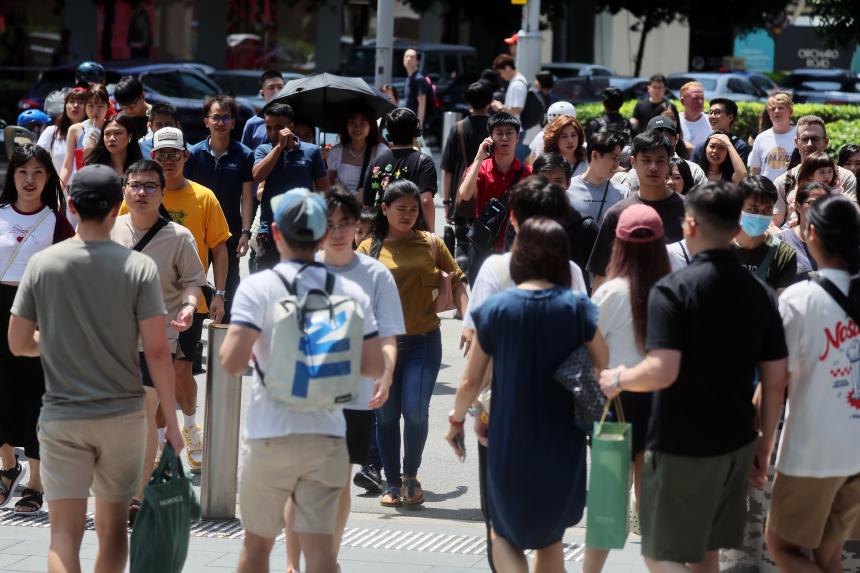SINGAPORE - The median income from work of households in Singapore was $10,869 a month in 2023, breaching $10,000 for the second year in a row.
The figure, which is for resident employed households, rose from the year before, growing by 7.6 per cent from $10,099 in 2022, according to data released by the Singapore Department of Statistics (SingStat) on Feb 7.
After accounting for inflation across the year, the median household income rose 2.8 per cent in 2023.
Nevertheless, incomes grew at a slower pace on a per household member basis in 2023.
The median monthly income from work per household member rose 6.5 per cent in nominal terms to $3,500 in 2023, slower than the 8.6 per cent growth to $3,287 in 2022.
Nominal income refers to the amount of money earned before considering the effects of inflation.
In real terms, or after adjusting for inflation, the median monthly income per household member rose 1.7 per cent in 2023, slower than the 2.6 per cent increase in 2022.
The average monthly income from work per household member provides insight into income distribution among households, after accounting for differences in household size. This helps in understanding the economic well-being of households, adjusted for household size.
For example, some households may have only one breadwinner. If this individual’s income is high but he has many dependants, including elderly parents and young children, his income per household member may be relatively lower than that of another individual who has no dependants, said OCBC Bank chief economist Selena Ling.
Households that earned the least saw their nominal incomes grow at a slower pace compared with higher-income households, the data showed.
To measure how households in different income groups fared in terms of income growth, all resident employed households were ranked by SingStat from the lowest to the highest, based on monthly household incomes per household member. They were then divided into 10 equal groups, or deciles.
In 2023, this measure rose between 2.5 per cent and 6.8 per cent in nominal terms across the 10 income groups.
The first decile or group with the lowest household incomes saw the slowest average income growth per household member in 2023, at just 2.5 per cent to $706 in nominal terms. After accounting for inflation, their incomes fell by 1.7 per cent.
Notwithstanding this, SingStat noted that some resident employed households in the lowest decile owned a car (16 per cent), employed a domestic worker (14.7 per cent), lived in private property (8 per cent) or had household reference persons aged 65 and above (36.6 per cent). The household reference person may refer to the oldest member or main income earner, among others.
Associate Professor Walter Theseira, a labour economist from the Singapore University of Social Sciences, said the first decile includes a “significant proportion of richer retiree households” whose members could be working only part-time and hence would not have much income from wages.
He said one way to gauge how poorer households fared in terms of income growth is to look at household incomes by housing type.
Households occupying one- and two-room flats actually saw their average monthly nominal income per household member rise to $2,129 in 2023 from $1,929 in 2022.
The 10th decile or group of households with the highest incomes saw average nominal household income per household member grow 3.1 per cent to $14,803.
After adjusting for inflation, however, this group saw the biggest income drop among all 10 groups – by 1.9 per cent in 2023 compared with 2022.
To cushion the impact of rising costs of living and the increase in the goods and services tax to 9 per cent, the Government rolled out more support measures in 2023.
Average annual government transfers per household member rose across all dwelling types, from one-room public housing flats to private property.
Resident households, including households with no employed people, received $6,371 per household member on average from government schemes in 2023, up 8.7 per cent from the $5,859 received in 2022.
Those living in one- and two-room public housing flats continued to get the most government transfers in 2023. They received $13,623 per household member on average from government schemes, about two times what their peers in four-room and five-room and executive flats received.
As a result, the income inequality among households, which is measured by the Gini coefficient, continued to narrow.
The Gini coefficient based on household income from work per household member fell for the third consecutive year to 0.433 in 2023 from 0.437 in 2022, before accounting for government transfers and taxes.
After adjusting for government transfers and taxes, the Gini coefficient fell further to 0.371 in 2023.

Editor’s note: In an earlier version of the story, we said that the median income rose by 2.8 per cent after accounting for changes in household purchasing power. SingStat has clarified that besides inflation, there may be other factors that affects one’s purchasing power, such as credit and interest rates.


